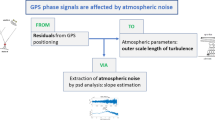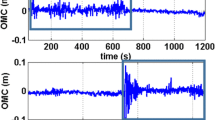Abstract
Multipath, a highly autocorrelated signal is observable phenomena during time periods longer than the sidereal period of Global Positioning System (GPS) satellites in their constellations. Multipath pattern and sidereal repeat time interaction are examined in terms of time series correlations of topocentric coordinates using GPS code and phase observations collected at high and low frequencies. The horizontal and vertical components at 5 and 30 s sampling rates are analyzed to detect and remove multipath classified by their M P 1 levels and baseline lengths. For the selected 11 stations that have 24-hour data from CORS stations in the USA and Turkey, the repeat times of the GPS constellation were identified as a function of maximum cross-correlation of adjacent time series. The multipath interference signal from two-day time series data is removed by an adaptive filter to improve time series of coordinate estimates. After the filtering process, an effective epoch based position tracking has been accomplished, especially in the height component. The position errors disappeared to maximum possible extent in the pseudo-range measurements. Up to 70% improvement for the phase derived coordinates in reflective environment has been achieved over the baselines ranging from 1 km to 175 km. For the phase observables, the filter success directly related to the multipath level which is specific to the station.










Similar content being viewed by others
References
Agnew DC, Larson KM (2007) Finding the repeat times of the GPS constellation. GPS Solutions 11:71–76
Bilich A, Larson KM (2007) Mapping the GPS multipath environment using the signal-to-noise ratio (SNR). Radio Sci 42(RS6003):1–16. https://doi.org/10.1029/2007RS003,652
Bock Y (1991) Continuous monitoring of crustal deformation. GPS World 2(6):40–47
Choi K, Bilich A, Larson KM, Axelrad P (2004) Modified sidereal filtering: Implications for high-rate GPS positioning. J Geophys Res 31:L2608. https://doi.org/10.1029/2004GL021,621
Dach R, Hugentobler U, Fridez P, Meindl M (2007) Bernese GPS Software Version 5.0. Bern
Dixon TH (1991) An introduction to the global positioning system and some geological applications. Rev Geophys 29:249–276
Dong D, Fang P, Bock Y, Webb F, Prawirodirdjo L, Kedar S, Jamason P (2006) Spatiotemporal filtering using principal component analysis and Karhunen-Loeve expansion approaches for regional GPS network analysis. J Geophys Res 111:B405. https://doi.org/10.1029/2005JB003,806
Douglas SC (1999) Introduction to adaptive filters. In: Madisetti VJ, Williams D (eds) The Digital Signal Processing Handbook. chap 18. CRC Press LLC, Boca Raton
Estey LH, Meertens CM (1999) TEQC: The multi-purpose toolkit for GPS/GLONASS data. GPS Solutions 3(1):42–49
Ge L, Chan HY, Han S, Rizos C (2000a) Adaptive filtering of continuous GPS results. J Geodesy 74 (7-8):572–580
Ge L, Han S, Rizos C (2000b) Multipath mitigation of continuous GPS measurements using an adaptive filter. GPS Solutions 4(2):19–30
Genrich JF, Bock Y (1992) Rapid resolution of crustal motion at short ranges with the Global Positioning System. J Geophys Res 97(B3):3261–3269
Haykin S (1991) Adaptive filter theory, 2nd edn. Prentice-Hall Inc., London
Herring TA, King RW, McClusky SC (2010) Introduction to GAMIT/GLOBK: Release 10.4. Cambridge
Hilla S, Cline M (2004) Evaluating pseudorange multi-path effects at stations in the national cors network. GPS Solutions 8(4):253–267
Jin SG, Luo O, Ren C (2010) Effects of physical correlations on long-distance GPS positioning and zenith tropospheric delay estimates. Adv Space Res 46(2):190–195
Kaplan ED, Hegarty C (2006) Understanding GPS: Principles and applications, 2nd edn. Artech House Inc., Boston
Kim D, Langley RB (2001) Mitigation of GPS carrier phase multipath effects in real-time kinematic applications. In: IONGPS, vol 2001, Salt Lake City, pp 2144–2152
Larson KM, Bilich A, Axelrad P (2007) Improving the precision of high-rate GPS. J Geophys Res 112(B05422):1–11. https://doi.org/10.1029/2006JB004,367
Liu H, Li X, Ge L, Rizos C, Wang F (2011) Variable length LMS adaptive filter for carrier phase multipath mitigation. GPS Solutions 15(1):29–38
NGS (2014) Continuously operating reference station (CORS). http://www.ngs.noaa.gov/CORS/
Park KD, Nerem RS, Schenewerk MS, Davis JL (2004) Site-specific multipath characteristics of global IGS and CORS GPS sites. J Geodesy 77(12):799–803
Proakis JG (1995) Digital communications: Communications and signal processing. McGraw-Hill, NY
Ragheb A, Clarke P, Edwards S (2007) GPS sidereal filtering: coordinate- and carrier-phase-level strategies. J Geodesy 81(5):325–335
Satirapod C, Rizos C (2005) Multipath mitigation by wavelet analysis for GPS base station applications. Surv Rev 38(295):2–10
Seepersad G, Bisnath S (2015) Reduction of PPP convergence period through pseudorange multipath and noise mitigation. GPS Solutions 19(3):369–379
Souza E, Monico J (2004) Wavelet shrinkage: high frequency multipath reduction from GPS relative positioning. GPS Solutions 8(3):152–159
Sridhar M, Krishna CS, Reddy KJS, Kumar MM, Lakshmi NS, Ratnam DV (2016) Mitigation of gps multipath effects using adaptive normalized lms algorithm. ARPN J Eng Appl Sci 11(15):9276–9279
Swathi N, Indira Dutt VBSS, Sasibhushana Rao G (2016) An adaptive filter approach for GPS multipath error estimation and mitigation. Springer India, New Delhi, pp 539–546
Wdowinski S, Bock Y, Zhang J, Fang P, Genrich J (1997) Southern California permanent GPS geodetic array: Spatial filtering of daily positions for estimating coseismic and postseismic displacements induced by the 1992 Landers earthquake. J Geophys Res 102:18,057–18,070
Yedukondalu K, Sarma A, Kumar A (2010) Mitigation of GPS multipath error using recursive least squares adaptive filtering. In: 2010 IEEE Asia Pacific Conference on Circuits and Systems (APCCAS), pp 104–107
Yedukondalu K, Sarma AD, Srinivas VS (2011) Estimation and mitigation of GPS multipath interference using adaptive filtering. Progress Electromagn Res M 21:133–148
Zheng DW, Zhong P, Ding XL, Chen W (2005) Filtering GPS time-series using a Vondrak filter and cross-validation. J Geodesy 29(6-7):363–369
Zhong P, Ding X, Yuan L, Xu Y, Kwok K, Chen Y (2010) Sidereal filtering based on single differences for mitigating GPS multipath effects on short baselines. J Geodesy 84(2):145–158
Zumberge JF, Heflin MB, Jefferson DC, MM Watkins FHW (1997) Precise point positioning for the efficient and robust analysis of GPS data from large networks. J Geophys Res 102(B3):5005–5017
Acknowledgements
The GPS data were provided from the online service of the CORS network managed by the USA National Geodetic Survey. This research was financially supported by the Research Fund of Selcuk University under grant 09-101-058. We also thank Barbaros C. Ipek (Konya Metropolitan Municipality) for providing GPS CORS network data for Konya region. We are grateful the anonymous reviewers for their helpful and constructive comments, and suggestions for improving the paper.
Author information
Authors and Affiliations
Corresponding author
Additional information
Communicated by: H. A. Babaie
Rights and permissions
About this article
Cite this article
Üstün, A., Yalvaç, S. Multipath interference cancelation in GPS time series under changing physical conditions by means of adaptive filtering. Earth Sci Inform 11, 359–371 (2018). https://doi.org/10.1007/s12145-017-0331-5
Received:
Accepted:
Published:
Issue Date:
DOI: https://doi.org/10.1007/s12145-017-0331-5




